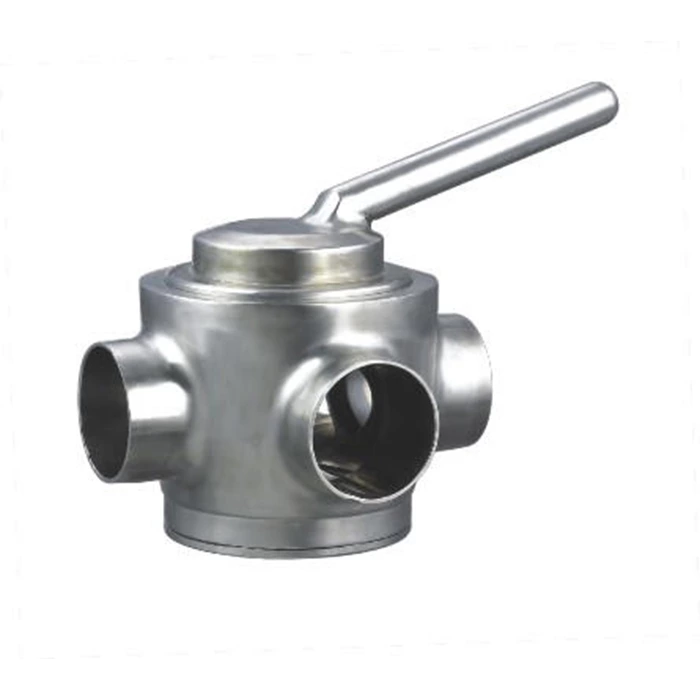The Difference Between Sanitary Valves
Sanitary Valve difference
Sanitary valves are just a general term, which are divided into ball valves, butterfly valves, check valves and other types.
1. The sealing surface of the ball valve is a spherical surface
2. The sealing surface of the butterfly valve is a circular cylindrical surface
3. The sealing surface of the check valve is a circular plate
Valve
I. Definition of valve:
"Valve" is defined as a device used to control the direction, pressure and flow of the fluid in a fluid system. A valve is a device that allows the medium (liquid, gas, powder) in the piping and equipment to flow or stop and can control its flow.
II. There are many ways to classify valves according to the different functions of the opening and closing valves. Here are the following types.
1. Classification by function and purpose
(1) Check valve: Check valve is also called one-way valve or non-return valve. Its function is to prevent the medium in the pipeline from flowing back. The bottom valve of the water pump suction valve also belongs to the check valve category.
(2) Safety valve: The function of safety valves is to prevent the medium pressure in the pipeline or device from exceeding the specified value, thereby achieving the purpose of safety protection.
(3) Regulating valve: Regulating valves include regulating valves, throttling valves and pressure reducing valves, which are used to regulate the pressure, flow and other parameters of the medium.
(4) Diverter valve: Diverter valves include various distribution valves and steam traps, which are used to distribute, separate or mix the medium in the pipeline.
2. Classification by nominal pressure
(1) Vacuum valve: refers to a valve with a working pressure lower than the standard atmospheric pressure.
(2) Low-pressure valve: refers to a valve with a nominal pressure PN ≤1.6Mpa.
(3) Medium-pressure valve: refers to a valve with a nominal pressure PN of 2.5, 4.0, and 6.4Mpa.
(4) High-pressure valve: refers to a valve with a nominal pressure PN of 10 to 80Mpa.
(5) Ultra-high pressure valve: refers to valves with nominal pressure PN ≥ 100Mpa.
3. Classification by working temperature
(1) Ultra-low temperature valve: valves for medium working temperature t < -100℃.
(2) Low temperature valve: valves for medium working temperature -100℃ ≤ t ≤ -40℃.
(3) Normal temperature valve: valves for medium working temperature -40℃ ≤ t ≤ 120℃.
(4) Medium temperature valve: valves for medium working temperature 120℃
(5) High temperature valve: valves for medium working temperature t > 450℃.
4. Classification by nominal diameter
(1) Small diameter valve: valves with nominal diameter DN ≤ 40mm.
(2) Medium diameter valve: valves with nominal diameter DN of 50 to 300mm.
(3) Large-diameter valve: valve with a nominal valve DN of 350 to 1200 mm.
(4) Extra-large-diameter valve: valve with a nominal diameter DN ≥ 1400 mm.
5. Classification by structural characteristics
(1) Gate valve: the opening and closing part (valve disc) is driven by the valve stem to move up and down along the center line of the valve seat;
(2) Plug valve: the opening and closing part (gate valve) is driven by the valve stem to move up and down along the center line perpendicular to the valve seat;
(3) Plug valve: the opening and closing part (conical plug or ball) rotates around its own center line;
(4) Swing valve: the opening and closing part (valve disc) rotates around the axis outside the seat;
(5) Butterfly valve: the opening and closing part (disc) rotates around the fixed axis inside the valve seat;
(6) Sliding valve: the opening and closing part slides in a direction perpendicular to the channel.
6. Classification by connection method
(1) Threaded valve: The valve body has internal or external threads and is connected to the pipe thread.
(2) Flange valve: The valve body has a flange and is connected to the pipe flange.
(3) Welded valve: The valve body has a welding groove and is welded to the pipe.
(4) Clamp valve: The valve body has a clamp and is connected to the pipe clamp.
(5) Sleeve valve: The valve body is connected to the pipe by a sleeve.
(6) Wafer valve: The valve and the two ends of the pipe are directly clamped together with bolts.
7. Classification by driving method
(1) Automatic valve refers to a valve that does not require external force to drive, but relies on the energy of the medium itself to make the valve move. Such as safety valve, pressure reducing valve, steam trap, check valve, automatic regulating valve, etc.
(2) Power-driven valve: Power-driven valve can be driven by various power sources.
Electric valve: A valve driven by electricity.
Pneumatic valve: a valve driven by compressed air.
Hydraulic valve: a valve driven by the pressure of a liquid such as oil.
There are also combinations of the above drive methods, such as pneumatic-electric valves.
(3) Manual valve: a manual valve uses a handwheel, handle, lever, or sprocket to operate the valve manually. When the valve opening and closing torque is large, a wheel or worm gear reducer can be installed between the handwheel and the valve stem. If necessary, a universal joint and a drive shaft can also be used for remote operation.
